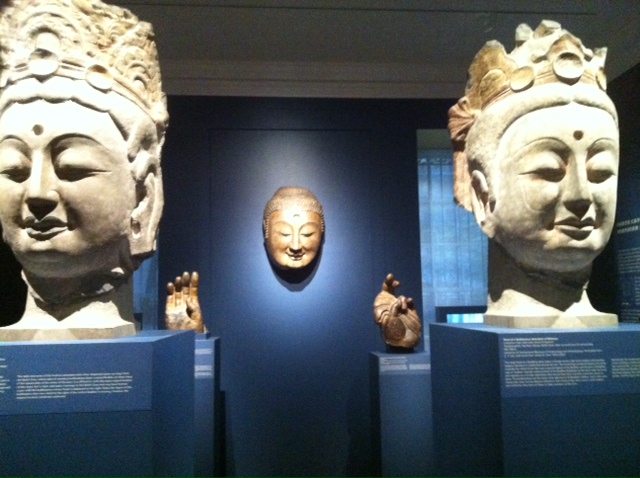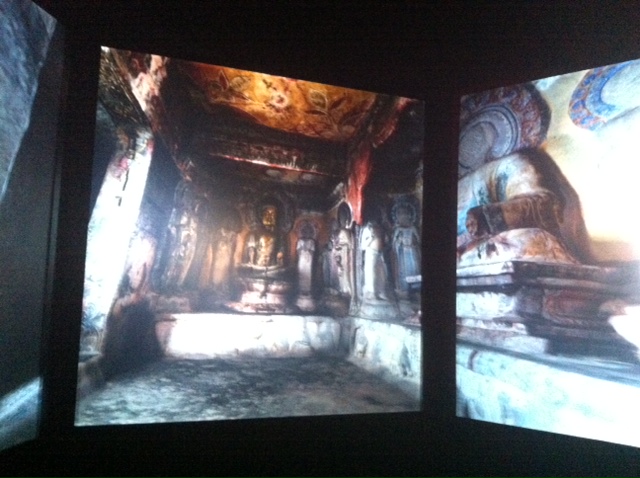Came across the following article and find it interesting how they created this: something like time-travel.
http://www.huffingtonpost.com/gabrielle-selz/alternate-reality-of-a-bu_b_1903427.htmlPart sculptural exhibit, part 3-D installation piece, part research project, Echoes of the Past: The Buddhist Cave Temples of Xiangtangshan now on view at the Institute for the Study of the Ancient World, New York Universities, marries 21st century technology with ancient object in an effort to bridge the gap between past and present, and between East and West.
I do not usually write about ancient art, preferring instead to focus on contemporary, site-specific installation pieces in which viewer and art object merge in the creative imaginings of the artists. But entering the darkened room and watching the film that "virtually" reunited the past with ancient sculptures that had long since vanished from their pedestals, I was astounded by how the use of modern digital imaging can create an otherworldly experience. It is as if we are seated in these ancient Chinese caves, not the caves as they are now, but as they once were, intact and in situ, before time and looting all but destroyed them. Touching on archeology, history, religion as well as the political fallout due to pillaged artifacts, Echoes of the Past unites viewers in such a recreated installation piece.
Among the major artistic achievements of the Northern Qi Dynesty were the cave temples and monumental stone sculptural carvings of Xiangtangsham. Located in the rural coal-mining area of Southern Hebei Province, China, these sites, first constructed between 550 and 557 CE, once held grand limestone sculptures of Buddhas with attending figures, set against a backdrop of floral motif walls and ceilings. Today,what remains intact has been damaged after centuries of erosion and environmental pollution. Nearly all the freestanding images have been removed and many of the relief images have had their heads and hands cut away, courtesy of plundering in the service of the 20th century art market. Visitors to the present-day caves in China are confronted with ghostly, headless remnants; conversely, visitors to major museums around the world view sculptures that are bereft of their original setting and cannot begin to fathom the grandeur and mystery of the original altars.
The Xiangtangshan Caves Project: Reconstruction and Recontextualization was conceived as a way to bridge this gap, between displaced object and original home, as well as a means to combine old-fashioned scholarship with modern innovation and thereby provide an immense kinetic re-creation of one of the caves.
With the use of 21st century technology, an international team of experts has gathered together a digital database of images and information on the caves and sculptures. For six years, researchers from the University of Chicago traveled the museums and collections around the world examining and scanning with 3-D cameras. Now, a selection of sculptures has been brought together with the 3-D model installation to create a viewing experience that evokes the configuration, size and design of the caves.

It's a time-travel experience. Three screens surround viewers, who, sitting in the dark, are at once invited into the research world of fact-finding and digital documentation, then transported back to the original time and place of the caves. Serene and beautiful, the reconfigured Buddhas open up around one like lotus flowers on a pond. Slowly, the images change, as if we are standing alone in the room and time itself is unfolding forward, the images spin across the screens and gradually the viewer is brought along through the use of historical photographs, back to the twenty-first-century where we witness present day worshipers lighting incense at the temple site.

This is what great installations provide, whether by one artist or a curatorial board, the sense of entering a narrative, of dropping into not just the imagination of an artist, but the artwork itself. Echoes of the Past invites us to apprehend an experience otherwise unavailable -- an alternate reality -- one that existed a long time ago, and save for the technology of our digital new age, could not have been realized again.
Echoes of the Past is on view now through January 6, 2013
Photos are the author's own